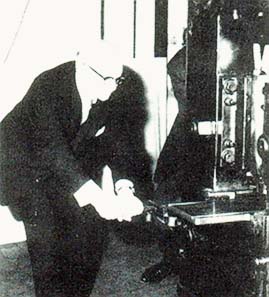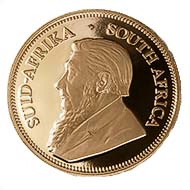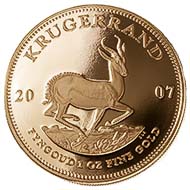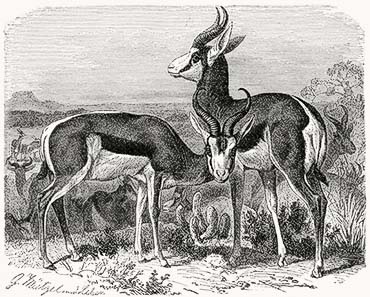by courtesy of Barbara Balz / World Money Fair
Pic. 1: The first Krugerrand is minted.
On July 3, 1967 the South African Mint in Pretoria issued the first Krugerrand coins (pic. 1 and 2). A new concept was at the bottom of this: These coins could be used as circulation money; however, they did not bear a nominal value. Instead, the exchange rate at which South African banks traded Krugerrand coins was fixed daily, according to the price of gold. So, from the start the Krugerrand was conceived as a bullion coin of changing value. Therefore, the South African Mint chose the most important weight unit as the basis of their new coin – the troy ounce, equal to 31.1 g. Thus, the Krugerrand was the first small gold bullion in form of a coin. It was extraordinarily successful. From 10,000 coins minted each year, from 1967 to 1969, output surged to 90,018 Krugerrands in 1970, 686,400 units in 1971 and even 869,300 in 1973.
Currency weakness was the reason for the run on gold
Pic. 2: Krugerrand 2007 – That year the Krugerrand ‘s 40th anniversary was celebrated.
Pic. Original diameter 3.25 mm
The reason why the Krugerrand became an export hit lay in international currency policies. Since World War II, the American dollar had been the anchor and reserve currency. But when, in the 1960s, the US economy was flagging and it was foreseeable that the relation of the dollar to gold needed to be redefined, people switched to buying precious metals, which made the price of gold and silver skyrocket. When the United States eventually gave up the gold-dollar peg, it caused inflation and everybody who could afford it invested in tangible assets.
Naturally, the Krugerrand benefited from that development. After all, it offered security even to retail investors who could rely on having real gold and not worthless paper in their bank safes. To satisfy market demands smaller coins were introduced in 1980 – the half-ounce Krugerrand with a weight of 16.97 g, the quarter-ounce weighing 8.48 g and tenth-ounce coin weighing 3.39 g. South Africa could notably improve its foreign trade balance by exporting gold in form of bullion coins.
The motives
Pic. 3: The springbok – here on a 19th century drawing – is considered a South African national symbol. From Wikipedia.
In 1967, when the Krugerrand was introduced, John Vorsters was at the head of the South African Apartheid state, ruling with an iron fist. Under his predecessor, ANC opposition inside the country had been annihilated. Nelson Mandela had been imprisoned on Robben Island 3 years earlier and many of his combatants had left the country. Thus, it is hardly surprising that the Krugerrand was designed according to Boer ideas, featuring national symbols of “white” South Africa on the obverse and reverse of the coin.
The obverse bears a portrait in profile of Stephanus Johannes Paulus Kruger, looking to the left (pic. 5). This political figure, known by the name of Oom Paul or Ohm Kruger (Oom is Afrikaans for “uncle”), is one of the Boers’ most important national heroes (see also “Berlin and South Africa”).
The reverse depicts a springbuck or springbok (Antidorcas marsupialis), heraldic animal of the Republic of South Africa. This magnificent animal lives in the savannah and resembles a gazelle (pic. 3). It owes its name to the fact that it can leap as high as 12 feet in the air when startled. Moreover, the antelope’s speed is remarkable. The South African springbok is capable of reaching 55 miles per hour, thus being one of the world’s fastest animals.
Because of these characteristics the springbok became the heraldic animal of the Boer Republic of South Africa. It has also been an inspiration for South African sports teams; many were named after it, above all, the successful South African national rugby team, known as “the Springboks.”
And why does the Krugerrand still look like a Krugerrand?
Abb. 4: Nelson Mandela and Frederik de Klerk meeting on the occasion of the World Economic Forum in Davos in 1992. From Wikipedia.
Economic problems, international pressure and, of course, the activities of the anti-apartheid movement in the country made South African president Frederick W. de Klerk establish contact with the ANC, the most important group of anti-apartheid activists. It was a long and difficult way that led to the first free elections in a democratic South Africa. Although it cannot be described here in detail, we should recall that the change of power took involved much less bloodshed than everybody in and outside South Africa had feared – thanks to the reasonable behavior of all those who played a part in this process. Probably that was a reason why many symbols of former South Africa were kept and did not have to be abolished.
Nelson Mandela himself became a symbol of national reconciliation, for instance, when he visited the widow of the man under whose rule he had been sentenced to prison. So, if Mandela could make peace even with his direct opponents, why should he turn against the old national symbols?
After the political change, renaming was carried out very hesitantly and most monuments from the times of white minority rule were allowed to remain. Also Paul Kruger was not removed from his place on the world’s best-known bullion coin.
It was Nelson Mandela in person who stepped forward to defend the springbok. That symbol was especially controversial as people associated it with the coat of arms of the apartheid state. In 1997, it was eliminated from the logo of South African Airways. But it continues be the symbol of the national rugby team, thanks to Nelson Mandela who said that he used to eagerly follow the matches of “his” team already during the years he spent in prison.
So, after all, the springbok survived on the Krugerrand coin, too, together with the picture of Kruger – standing as a signal of hope that reconciliation is possible. South Africans have given us the proof.
If you want to know more about Southafrican coins, please don’t miss to attend the World Money Fair 2010. Southafrica is the Guest of Honor. http://www.worldmoneyfair.ch/wmf/english/guest_of_honor.html








